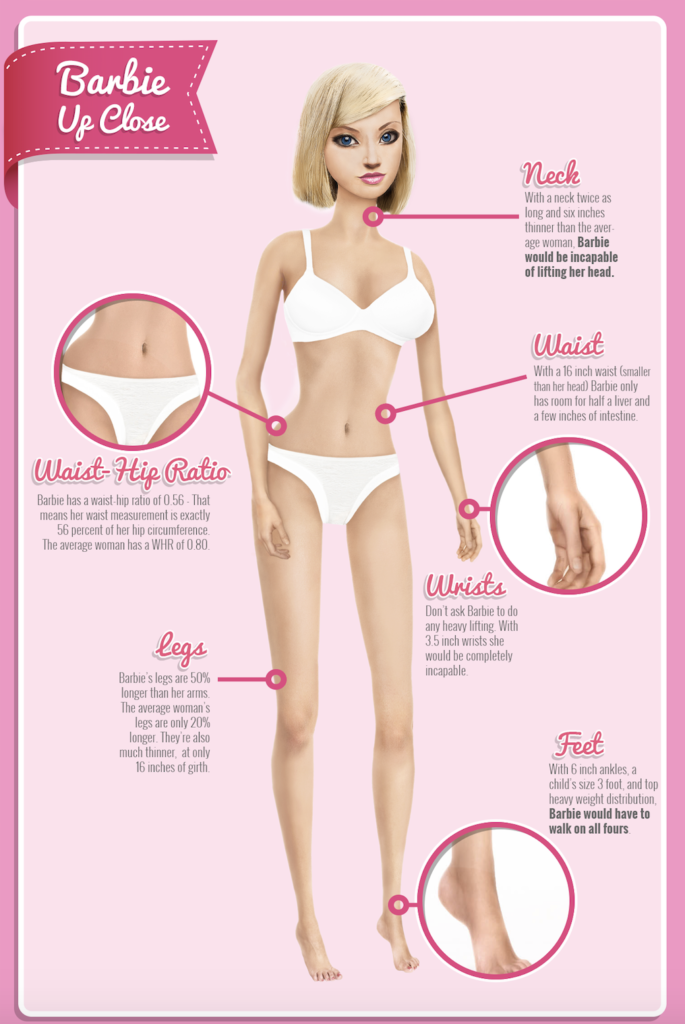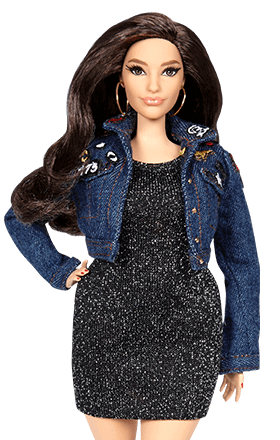Scrolling through my Instagram feed, I saw the hijabi, Olympian fencer Ibtihaj Muhammad partnering with the biggest brand from my childhood: Barbie. As a young girl, I never imagined a hijabi barbie, let alone one that wasn’t white and blonde. I decided to look further into what Muhammad was promoting. Together, Barbie and Airbnb created a life-sized Barbie Dream House, complete with an infinity pool, memorabilia-filled rooms, and fencing lessons from Muhammad herself.

The sixty-year-old Barbie brand is adapting to changing society and capitalizing on some of the biggest trends of this generation. With a growing focus on diversity, strategic partnerships, and a mastery of media, Barbie is more than just a toy, it’s an empire.
Barbie Bimbo is No More

Barbie’s history with diversity is a rocky one. The brand has received far too many hate messages about it’s severely ill-proportioned doll. As shown on the figure to the right, obtaining a “Barbie body” is quite literally impossible. In real life, her neck would not be able to support her head, her waist can fit half of a liver and a few inches of intestines, and she would be unable to walk with her child’s foot size of 3.
People complain about skinny, photoshopped models depicting unrealistic body expectations, but Barbie was the worst culprit, with 92% of impressionable, American girls looking to her impossible figure. As millennial women became mothers, they decided that Barbie was unacceptable for their children. Thus, according to this Times Article, Barbie sales dropped 20% between 2012 and 2014. The brand’s sales were overtaken both by Lego, encouraging girls to build, and Hasbro’s strong, independent “Elsa” doll dominating the market. Barbie knew it had to adapt to survive.

How, you might ask? Barbie realized that diversity is selling in today’s society. Girls like me never used to see themselves reflected in toys, on television, or in power. But today, people like Nasim Pedrad, Jameela Jamil, and Congresswomen Ilhan Omar and Rashida Tlaib are dominating the news cycles. Kim Kardashian, Beyonce, and Rhianna are leading a movement to represent a more curvaceous body type. As a result, Barbie began to release dolls of different races, hair colors, and occupations. In 2016, Barbie made the biggest, most complex move of all: They introduced four new body types.

Now, you can get Barbie in Tall, Petite, and Curvy, along with the original doll. There are 7 skin tones, 22 eye colors, and 27 hair styles, according to CNN. Most recently, Barbie released specially designed dolls that come with a wheelchair or prosthetic leg. The “Career Dolls” feature women as marine biologists, astrophysicists, and engineers. Gone are the moments like October in 1992 when the “Teen Talk” Barbie was made to say “math class is tough.” Women’s empowerment is the new chic, and Barbie is taking notes.

Barbie Knows How to Make Friends

Mattel and Barbie have well-placed strategic partnerships. They came out with their “Role Models” campaign in 2015, featuring dolls created in the likeness of amazing women in politics, science, athletics, and so much more. Some role models are not famous, as is the case with Iwona Blecharczyk, a professional truck driver from Poland. But in choosing celebrities like Gabby Douglas, Ibtihaj Muhammad, and Naomi Osaka, Barbie is bringing a vast amount of positive media attention to their company.

In my opinion, their best celebrity partnership is Ashley Graham. As one of the leading activists in the body positivity movement, she is a social media sensation and famous supermodel. Her 9.4 million followers love her, and have propelled her into landing jobs with Vogue Magazine, Harper’s Bazaar, Glamour, and the coveted Sports Illustrated swimsuit cover. Adding Graham as a role model in 2016 helped launch Barbie’s body positivity line in the most millennial-centric way possible.
Barbie has learned to partner with more than just individuals. The aforementioned Airbnb partnership brought extensive media attention to both companies, and Airbnb donated to the Barbie Dream Gap Project, helping girls achieve greatness. This was truly a genius move, and one of the most creative marketing ploys I’ve seen in a long time.
Barbie on Screen
Barbie is quite possibly the most technologically savvy doll there is. Her Instagram is worth following, with a colorful feed and engaging posts. Barbie wants you to interact with her by answering questions and sharing stories on Instagram. She posts about celebrities like BTS and provides exciting videos geared to younger teen audiences. One of the most recent posts was the “We’re Taking Over” music video.
The video features some of the most Insta-famous dancers from Dance Moms, Disney Channel, and other famous studios. The message is rooted in female empowerment, showing girls becoming president and other high profile leadership roles. While this video is too annoying for my 19-year-old senses to handle, it’s perfect for the age group they’re targeting. By using relatable influencers, a great message, and fun music, Barbie is bringing an exciting flavor to her Instagram profile, and you can watch the whole video via IGTV.
Barbie can also be found on the television screen. One day, I walked into my friends house and found her watching Barbie: Life in a Dreamhouse on Netflix. She said, “it’s kinda good.” My friend was not Barbie’s target audience, but there she was, interacting with the Barbie brand at eighteen. If someone searches “Barbie” on Netflix, he or she will find countless mini series and movies featuring the iconic doll. She doesn’t just dominate social media, she’s on your Netflix feed as well.
What’s the bottom line? Having a sixty-year-old brand plagued with controversy isn’t the end-all be-all. You can bounce back and assert yourself in the industry for years to come. It’s all about looking at your customers and determining exactly what will make the dollars flow into your pocket. Does a six-year-old care if Barbie partners with Ibtihaj Muhammad? No, but the mommy with the wallet most certainly will.